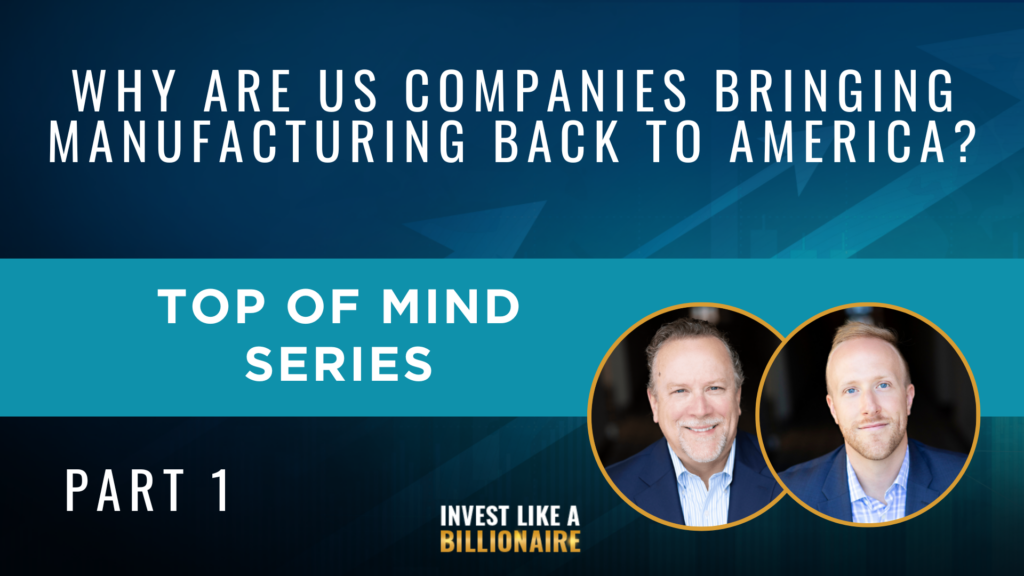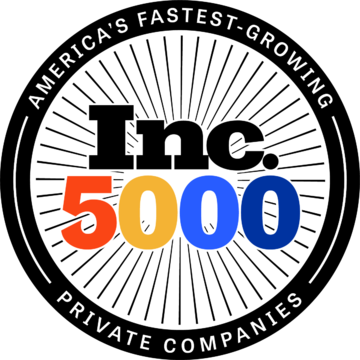
The past few years have completely upended the global supply chain. This, along with many other factors, is causing more and more companies to bring manufacturing back to America. But is this a short-term trend, or a fundamental shift in manufacturing? In this episode, Bob Fraser and Ben Fraser take a look at some of the factors that are driving businesses to repatriate their production and offer insights on why America is once again becoming a viable place to manufacture goods. They also explore the key benefits and opportunities and discuss how investors can take advantage of the growing trend.
—
Watch the episode here
Listen to the podcast here
Top of Mind: Why are US companies bringing manufacturing back to America? Part 1
Ben Fraser: Today we’re gonna focus on why us companies are bringing manufacturing back to the US. And so this kind of goes against, contrary to popular opinion of globalization and outsourcing all manufacturing overseas into third world or developing countries. And it’s really a trend that has taken a quick reversal. Really the past two years and ever since COVID changed a lot of things.
So we wanted to dive into this, talk about what’s driving this. And really as investors, again, our whole goal with this podcast is to find these trends that may be under the radar that are creating opportunities for investors. And we feel like this may be something that investors need to pay attention to.
Ben Fraser: Welcome back to the Invest Like a Billionaire podcast. I am a co-host Ben Fraser joined by fellow co-host:
Bob Fraser: Bob Fraser.
Ben Fraser: And today we’ve got a Top of Mind episode for you. So in this series, we do short snippets. And look at different things that are going on in the economy and different asset classes, different trends that we’re seeing and picking up on that we feel are noteworthy and worthy of investigation and want to share with our listeners.
And there’s usually little more short soundbites. And I’m really excited about today because Bob has some pretty cool information that he’s gonna talk a little bit about related to the industrial real estate space. And this is something we’ve been tracking with for a little bit ever since COVID upended the entire global supply chain and was really rewriting the whole space in the industrial world. We’ve been digging into some of these trends and excited to share some of these little snippets. We’re gonna have a lot more to share in the coming few weeks.
Bob Fraser: It’s an amazing time, right? There’s all this fear out there, which is great because fear creates opportunities. And we are also at the front end of some major shifts. In trends and that is the best time to get involved. We are, we’ve identified a key trend here that we’re very excited about.
This is a long term trend. I get excited, but it is not a trend. That’s gonna be a six month trend, right? That’s not a trend. I’m interested in a trend. That’s gonna go on for the next 10 to 20 years. That’s gonna create billions and trillions of dollars in value. That’s what that’s, we’re interested in.
We’re. We’re very pumped about this reality that this niche, that, that is pretty clearly gonna be a major win. And it’s this idea of the reassuring of us companies and it’s a very big deal. And you ask, why, why are companies doing it? Let me show you one chart.
That is just a little bit of, a little bit of a mind mindblower here. Can we see this? You got this chart there. Ben got it. Okay. So this is a mindblower. This is the manufacturing average wage in US dollars. And the red line is China. And so look at what’s happened to Chinese wages. It has been a 15 fold increase basically since 1999.
So Chinese wages are higher than Mexico. They’re higher than they’re higher than every other country. In fact, right now, China is very desperately trying to automate, and they’re the number one purchaser of robots right now, and robotic manufacturing. So people think China is this great cheap thing.
It’s not, it’s actually just as cost effective to manufacture in the United States today. If you count. The cost of transportation, if you add in robotics and automation, and if you add in transportation costs and if you throw in energy, it’s a whole different wall card.
Ben Fraser: Yeah. Okay. So I gotta pause you there because that is . That is nuts. So it’s nuts for those that are not watching this on YouTube or listening to it. The chart that Bob has pulled up here is over the last 20 years, what is the average wage? In different primary manufacturing companies, it has stayed flatter and has gone up.
So in most of these places, it’s trended up slightly, but in China, which has been a mega manufacturing Titan, the average wage has increased 15 fold, right? 15X
Bob Fraser: So most investors are thinking their data’s 10, 15 years old. So you’re thinking China’s this great manufacturing destination.
It was, and the issue is it’s just not anymore, and you add the geopolitical risk. You add the fact that they’re throwing people in prison for political disagreements. This is not, there’s no future. And then what very few people realize is that China is actually in their working age population is actually declining and has been for five years.
And so they actually, the number of people working in China is decreasing because of their one child policy. And so Chi China is a declining power. and they’re they’re, and what’s happened when you decrease the number of workers, guess what happens to the wage? And so it’s no big mystery.
So China is in its days as a superpower, as a manufacturing superpower. It’s not gonna disappear, but it’s not gonna dominate the world. Seen. And I’m just saying, I’m not saying next year, I’m saying the next 10, 20 years. So it is a very big deal. And so why are people coming back to America, I’ll show you.
I’ll shift that, I’ll show you another couple slides here. Hold on, let me pull it up. And what’s
Ben Fraser: really interesting too, which we’re gonna talk more about in future episodes, but we’re really seeing the trend for globalization, which when I was in school, 15 years ago in business school, that was the big trend.
All these companies, these big companies go and drive. Higher profit margins to the bottom line by outsourcing, to developing countries, different manufacturing, different parts of the supply chain so that they can increase profit margins. But what’s really happening is we’re seeing since COVID the opposite trend has happened and it’s actually de-globalization.
And we’ll talk about more of that here soon, but it’s interesting too, if you zoom out a little bit over longer periods of time and data. It actually oscillates back and forth, right? As different factors impact the costs for outsourcing manufacturing versus keeping it in-house or domestic.
And so it’s the tides are shifting here and it’s pretty apparent and it’s gonna be a pretty mega trend as we’ll be talking about
Bob Fraser: The globalization trend started when China entered the world trade organization in 1990. They brought in this massive, hundreds of millions of cheap labor force into the world system.
And they were politically liberalizing. And the Western countries had no problem going there for manufacturing and they aggressively invested in their manufacturing capacity and it began this global trend towards globalization. and it’s now over. Globalization is dead and there’s a number of reasons, but suddenly the world is woken up to political risk.
Now I’m gonna back up here for its sec. And so we’ve seen you, you’ve seen warehouses and warehouse space across the United States and a dis distribution, et cetera. And manufacturing. Huge demand has been growing really for the last 10 years. And I have the chart here that shows eCommerce growth, and it’s just been ramping up higher and higher.
Of course here’s the COVID spike. You can see it on April of 20. ECommerce growth maxed, but what you’ve seen is a flattening. And we believe that the eCommerce trend isn’t, it’s not dead, but the growth is the bulk of the growth is over. We’re not gonna see a lot of growth.
So it would tell you maybe to not have to not time to. In industrial where industrial or, big box industrial space, warehouses and manufacturing. And, but it’s actually what’s happened since COVID is what’s happened is companies have suddenly realized that there is a supply chain and there is supply chain risk and in two things, they want to have inventory.
And where in the past inventory was considered evil , there was a, in the 1980s the whole world went to what’s told just in time manufacturing. And the idea is this is you want inventory to be delivered the moment, or you want inputs to your manufacturing process to be delivered the moment they’re needed and not a day before.
And so inventory was evil and because inventory costs money and so you had this just in time manufacturing, et cetera, that’s all out the window. Now everybody wants inventory now. And because they understand supply chain risk. And then, so you add the COVID supply chain risk, and now you add the fact that the world is waking up, that there really are.
Really bad actors on the global stage. Okay. And including you look at what you know Putin is doing of course and all of a sudden they’re CRA people are waking up and going, you, this is bad. We don’t want anything to do with Russia. And yet they’re the major suppliers of many metals and industrial inputs and including fertilizers and metals of all kinds of resources.
What are we gonna do? We better figure that out. You look at China and their repression of what’s free speech and. And human rights abuses all just, and people are waiting a minute. And now they’re, we, we think they have ambitions on Taiwan. Of course. How much work, how much do we really want to be doing with these guys?
And if there are hostilities that break out, what’s gonna happen in your supply chains? Exactly. These are things that we absolutely can’t ignore. And so all of a sudden, the world woke up, wait a minute, there is risk. And so everybody’s wanting to bring them back, add the fact that it doesn’t even cost that much more.
And you’re seeing a massive trend towards reshoring and re inventorying and building inventory. And re reassuring to, to the us. I have a couple charts here. I’ll show. So this is the red line here shows. So the blue line, this blue line is inflation.
The red line is actually industrial real estate. So you can see on a tear. And this is so interesting. So look at what’s happening in the little dark, oh, I don’t know what color that is. The dark blue, gray, I guess the number, the amount of industrial space completed. And you can see it’s really high.
So we’re seeing lots of completions, 300 million square feet, 300 million square feet and 18, another 300 million square feet and 19. Another 350,000 square feet in 20, looks like three’s about the same. And then almost 400,400 million square feet of industrial face completed in 22 is anticipated.
But look at the absorption. Yeah. Look at the absorption. And so during 21, Some 300 million square feet of industrial space completed. And the vacancy rate dropped from 4.9 to to, I think it’s 2.9% today. So we’re seeing massive amount of a space being built, and yet it’s being absorbed as rapidly as it’s being built.
And so it’s just amazing. This is a, this is from a. Latest demand estimate rises by 800 million square feet. This is from Prologis which is one of the largest industrial management companies. And they’re they have 5,800 customers who at least. Industrial space. And they’re saying they’re seeing demand of 138,000 square feet per client increased demand of that’s 800 million, 800 million square feet of demand.
That’s being asked of these managers right now. And
Ben Fraser: this is just of this one firm’s clients.
Bob Fraser: yeah, they’re big though. And then so you look here, this was just in the wall street journal recently, this article high natural gas prices push European manufacturers to ship to the us. So this is the killer we are in middle.
Of a pretty massive energy crisis, and this is not going away. And this, we need to do another top of mind on energy. And we I think we’ve covered some of this in previous podcasts but what’s happened in 2015 there emerged this narrative that. Fossil fuels were dead. And we don’t wanna invest in fossil fuels anymore.
And so they, so the world quit investing in fossil fuels to the tune of it’s. It’s dropped about 60%, the amount of money be invested to develop fossil fuel resources and fossil fuels are unique in that if you don’t put money in it, declines. Every year. And and it’s too late. Now that money that was never spent means those projects were never developed you can’t, there’s no levers to turn and no buttons to push to boost energy production right now.
And so what’s happened. America is in a very unique situation. Where’re the only country in the world. That has energy availability in the same locale as industrial demand. So supply and demand are literally geographically co-located right. China doesn’t have any energy.
They import all of it. Japan doesn’t have any energy. Europe doesn’t have any energy. Not any, not much, not enough. To support the demand it’s they’re importing America is the only country. America is actually a net exporter of fossil fuels. And it’s because the shell revolution and our natural gas is literally five times cheaper than in Europe or Asia.
and what does that do? If you have an energy intensive industry, there’s only one place in the planet you want it to be right. And that’s America, so we have a massive mega trend of reshoring re inventory that is just getting started right now. We’ve got probably 20 to 30 years of runway in this, just like the eCommerce trend that’s run its course.
Now there’s wave two. Of the reindustrialization of America that is yet to hit.
Ben Fraser: Yeah, I know. It’s so fascinating. You think about like you just showed and the e-commerce trend, there’s been a huge driver of industrial space with the shift to, online sales and needing to have big warehouses.
And Amazon’s been a big, driver of that, but it’s, it seems like it’s almost accelerated. If you look at that chart of absorption the past few years, Because not only just, there’s two, two big, slices within industrial. One is warehousing and one is manufacturing and warehousing has been, a big driver of industrial growth space, but now it’s actually
Bob Fraser: manufacturing that’s coming and you’re seeing that.
Chip manufacturers are announcing major new new builds. They just passed Congress just passed that law to basically bring chip manufacturing back to America. Of course it takes, years and years to develop that. But you think about these car manufacturers and you’ve you, you can’t ship a car because it lacks a $2 chip, would they be willing to pay $4 for that chip hell yes.
And it’s and get it made in America. Here’s another, this is from the wall street journal, also us companies on price to bring home record number of overseas jobs. Look at what’s projected 350,000 jobs in job announcements that have been projected just for this year.
And so you see a massive trend. This is actually you’re seeing manufacturing employment. Has been on the decline since 2000, 10, but all of a sudden it’s on the incline. Now we’re seeing manufacturing employment going up. And of course the new systems are largely automated.
So employment is never gonna be higher, but, and I’ll just make a shameless kind of, call it political if you want, but we need to open our borders and we need to bring in workers and, and we need a smart. A smart, intelligent immigration policy that helps America.
And brings in workers. The idea that, I think both wins are wrong, right? The left and the right. They’re just both wrong. We need good, smart immigration. We don’t need stupid immigration. So let’s fix some of these things. So here’s some of the reasons,
Ben Fraser: talk a little bit, talk about why this is a mega trend, or why is this something that’s going to. Take place over the next decade. If not even longer, why is this not just a little blip in the uh, this stuff
Bob Fraser: Takes massive amounts of time to build the warehouses to get them the energy going to shift, cancel contracts, maybe a five year manufacturing contract with a contractor.
And. In China, it just takes a long time for this to, and some companies it’ll take ’em five years to decide, Hey, we have to do this just to make a decision will take five years. It just takes a long time for, hun, a hundred thousand companies to decide they’re gonna do this.
They have to do this. And there’s the early adopters. And there’s the sure, the late adopters who just, it’s just gonna take time. And it’s, the pain is gonna get worse and worse. And so it is massively accelerated because of the pain of COVID where a lot of companies really lost everything because they couldn’t get parts.
And they’re not gonna forget that. They’re not gonna forget that. Now, if you have any inputs coming from Russia, You’re really thinking about what to do. And right. They’re the largest supplier of a whole, of the platinum group, metals of uranium, of fertilizers, all from Russia, number one, exporter in the world.
And if you, what are you gonna do? You better? You gotta share another source. So here’s some of the main reasons why, if this is from reassuring.org, Report some of the main reasons why people are reassuring and then the factors trending up social and ethical concerns are number one, so it’s like people are saying, I don’t wanna have anything to do with Russia. Or is, or G who is, throwing, democracy advocates in prison. I don’t want anything to do with that. And number that’s interesting. That’s number one, right? Number two was Walmart, $350 billion made in America campaign, right inventory. They want more inventory, the not up 300%, and this is in their survey. Was the price of electricity and gas. Wow. And and I actually, it actually predicted, I don’t know if you remember the conversation Ben. It was six, nine months ago.
I said energy is gonna be the main driver driving driving companies to America. It is, we are an energy superpower. America is an energy superpower and we’re the Saudi Arabia of coal and Saudi Arabia of natural gas. We’ve got a ton of it. So much so that they’re flaring off natural gas and that’s cause it’s so cheap.
It’s don’t know what to do with it. So we’ll just burn it off and that needs to stop, yeah it’s.
Ben Fraser: It’s interesting to me it seems like this, the kind of trend that, that, that drove globalization accounted for certain factors that up to that point were difficult to quantify, basically supply chain risk and energy price, risk and up until COVID those kind of worked great in, in school is always just in time.
Inventory was such. Such a cool concept, right? That you could have something arrive, when you needed in all these systems, there’s a lot of
Bob Fraser: concepts that are great.
Ben Fraser: It worked together perfectly to get it right when you needed it there. And it’s interesting how the, COVID exposed a lot of these shortcomings and how the global system has been set up and it basically.
Really underpriced the risks of that’s exactly
Bob Fraser: right. Yeah. That’s exactly right. Ben well said and it’s a it’s we’ve been over globalized. Yeah. Okay. The risks were massively underestimated and what happened is COVID exposed it, exposed the risks. And so it’s a lot of times, so these world crises don’t a lot of times, kill things, they just.
Push corpses off the cliff is what they do, , and that’s really what happened here. The COVID exposed this massive risk in supply chains and this over globalization, this far too aggressive globalization, and and and so it’s all changing, look at this warehouse in distribution Chart of real estate.
And you look at here’s what says, so the VA look at the vacancy dropping right now. It’s 2.9%. And the look at effective rent growth is ping. So it just shows there’s a squeeze, and I’m actually super excited because this is a massive mega trend. This is a 20 to 30 year mega trend.
But what we’re seeing now is because of this fear of recession, We’re seeing a counter trend to the mega trend, right? It’s a, and that is perfect. That is exactly what you want because now’s the time to buy. So right now we’re gonna be seeing great bargains coming in industrial real estate and you, and every in everything, if as people fear recession, as the banks tighten their lending, you’re already seeing.
It’s gonna cause prices to come down and so it’s gonna be perfect. So I love in the beginning of these mega trends to have a counter trend, going against the mega trend, the opposite way of the mega trend, those are perfect buying opportunities. Yeah,
Ben Fraser: it’s exciting. So for all of you that are interested by this and intrigued by some of this data, we’re gonna dive into this a little bit more in future episodes and we’ve got a lot more data that we’re excited to share, and Bob’s actually been, trying to hold it in because there’s a lot of information here he’s been doing research on and he is been doing this presentation on mega.
At a few different places and excited to share more of this with you, but it’s yeah, it’s really interesting of what’s driving, manufacturing coming back to the us. It seems very contrarian to what we’ve been hearing for the past 20 years and expecting. And so definitely see some opportunities here.
And so please stay tuned. We’ve got a lot more that of exciting. Yeah, we,
Bob Fraser: We’re gonna be we’ve got an industrial opportunity coming, but we’re gonna be looking for more. So we’re actively seeking out the best way to place capital right now and looking for the best ways to do this. And but we’re not any giant rush.
We, we think the next six to nine months and even 12 months might be ideal for investing in this market. Can’t wait, so awesome. To jump in.
Ben Fraser: All right thank you so much for listening. Please stay tuned for future episodes and as always, we appreciate your support. Thank you for all the reviews and sharing this with friends and family, and thank you to our listeners.








